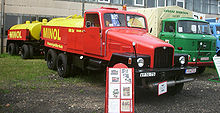Minol

Minol has been a German brand name for mineral oil products since 1949 . The name consists of the two first syllables of Min eralöl and Ol eum (lat. Oil).
history
As a result of the break-up of IG Farben after 1945, the gas station business in West Germany was continued under the Gasolin brand . A new distribution network was required to sell the products that were manufactured by the Leuna factories located in the Soviet occupation zone . The founding companies for this company were the German Fuel and Mineral Oil Center (DKMZ), founded on January 1, 1949 , which was later converted into the German Commercial Center (DHZ), and the German-Russian Naphta-AG (DERUNAPHT, founded in 1927, re-founded in 1946), from which VEB fuel sales emerged . Both founded VEB Kombinat Minol on January 1, 1956 with its trademark of the same name. The VEB was responsible for the supply of fuel and lubricants in the GDR . The company was based in the Minolhaus on Berlin's Alexanderplatz until it was demolished in 1968.
All VEB products were sold under the brand name Minol ; at the time of the fall of the Wall in the GDR, it had a level of awareness of 97% (sample institute: basic study Minol in the FRG, September 1990). This mark was not used in other countries. The brand colors of the old Minol were red letters on a yellow background. The mascot , the Minol oriole , was very well known in the GDR, and the advertising slogan was: “The Minol oriole is always ready for your well-being”. At the end of the GDR in 1989 there were around 1,250 Minol filling stations. This number also includes small stations and operating stations.
In June 1990, VEB Minol, under the leadership of the chairman of the board of Minol Mineralölhandel Aktiengesellschaft , Wolfgang Burkhardt, which was newly founded on June 8, 1990 , commissioned the creation of a modern brand design. The aim was to establish Minol as a separate brand in the unified Germany and to replace the previous colors red and yellow, as these were used internationally by the competitor Royal Dutch Shell . The new Minol design was created by Hartmut Ciesla-Andresen and Michael Pfister.
Minol Mineralölhandel AG operated three companies for fuel sales:
- Minol Nordtank GmbH based in Rostock
- Minol Zentraltank GmbH based in Potsdam
- Minol Südtank GmbH based in Chemnitz
In the course of the privatization of the GDR economy, MINOL Mineralölhandel AG and the Leunawerke refinery were sold on January 18, 1993 to the French mineral oil company Elf Aquitaine (98 percent) and Thyssen Handels Union AG (2 percent). The Leuna affair overshadowed this deal. Thyssen gave up its shares in April 1994. Elf Aquitaine stopped running the Minol brand two years after taking over the company. The trademark rights have been with the French mineral oil company Total , the successor company of Elf Aquitaine , since 2000 . In order not to let them expire, Total reopened three Minol petrol stations in Berlin, Chemnitz and Leipzig in 2003 and 2004 in a purple design. For economic reasons, however, the stations in Berlin and Chemnitz were closed soon afterwards.
Today there are still or again four Minol filling stations: in Leipzig-Lindenau , since May 2013 in Zeitz , since June 2013 in Heidenau and since January 2014 in Wesenberg .
Fuel supply
The fuels were mainly produced at VEB Leuna-Werke Walter Ulbricht . From a technical point of view, the fuel supply in the GDR was based on the TGL 6428 . Lignite-based fuel was sold until 1945. After the Second World War, it was switched to a smoldering basis , and soon afterwards it was increasingly necessary to switch to a petroleum basis. The fuels of the time had a low octane number, were not knock-proof and caused faults in the spark plugs . From 1960 it was possible to bring fuel with 78 octane on the market, this was offered at the time as VK "extra", VK "normal" was still on offer with 72 octane. At that time, fuels with 82 octane (“regular”) and 88 octane (“premium”) were already available in western Germany. Higher compression import cars such as the Skoda Felicia were sold in the GDR in a throttled version because the fuel quality was insufficient. In later years the fuel quality could be gradually improved.
In the second half of the 1980s, Minol offered the following fuels:
- Normal mixture (88 octane)
- Normal without oil (88 octane)
- Extra (94 octane)
- DK (diesel fuel)
The fuels mentioned were also available from Intertank (especially on the transit highways). There they were sold at red and yellow gas pumps for GDR marks. The following were sold at green and white petrol pumps for German DM:
- Special (91 octane)
- Super (98 octane)
- diesel
from approx. 1986 additionally:
- Special lead-free (91 octane)
- Super unleaded (95 octane)
Identical names
The name is identical to Minol Messtechnik W. Lehmann . However, this is purely coincidental.
Web links
- The history of Minol on the Total homepage ( Memento from March 12, 2007 in the Internet Archive )
- Minol is back Report on the reopening of two Minol filling stations
- minol-buch.de Book about Minol (not available in bookshops)
- LVZ online portal: Mascots changing: Minol oriole with baseball cap - pants too short, beak too pointed - In the 1960s, the Minol oriole fluttered into the hearts of many East German motorists. It was blue and looked like an oil can. Why it has a successor and who designed it. Retrieved June 14, 2020
Individual evidence
- ↑ The carburetor fuel "Extra" . In: Motor Vehicle Technology 11/1962, pp. 476–477
- ↑ What is the difference between Minol and VEB Minol. Retrieved December 12, 2019 .



